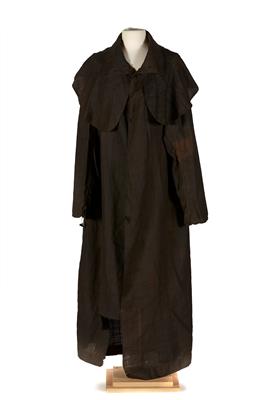Executioner's Cloak
Download media
Object number01075
TitleExecutioner's Cloak
DescriptionThis cloak was used at the executions of the Radical Weavers John Baird and Andrew Hardie in Stirling on 8 September 1820. Convicted of High Treason, the pair were sentenced to be hanged and then beheaded in front of the town’s Tolbooth.
The cloak was worn by Thomas Moore, a medical student from Glasgow, who was brought in after the Stirling hangman refused to do the job. It represents the culmination of a period of revolt that changed the country, a tale of suppression, insurrection and intrigue.
In 1820, Scotland was in upheaval. The end of the Napoleonic Wars in 1816 saw a huge number of men returning from the continent, looking for work. The Corn Laws of 1815 had pushed up prices and wages were devalued. The 1819 Peterloo Massacre in Manchester had stoked resentment. The working man felt powerless and put-upon.
This led to the Radical Rising. Weavers from Central Scotland were at the forefront of the demand for reform. April 1820 saw a week of strikes and unrest. Government spies are said to have played a part in stirring up the radicals. A group of about 40 radicals, led by Baird and Hardie (who had both seen military service) marched towards the Carron Company Ironworks to seize weapons. After a short battle at Bonnymuir they were captured with others in their band and imprisoned at Stirling Castle. After interrogation and trial, the other radicals were transported for life.
Baird and Hardie, as leaders, suffered a grimmer fate. Yet at their execution they declared that they died ‘for the cause of Truth and Justice’.
Production date 1820
Object nameCloak
MaterialWool
Dimensions
whole Length: 1400 mm
hood Width: 300 mm
hood Width: 300 mm


